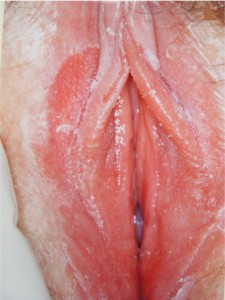The diagnosis of vaginal discharge is based on a History, Physical Exam, and a few simple diagnostic tests.
History
Ask the patient about itching, odor, color of discharge, painful intercourse, or spotting after intercourse.
- Yeast causes intense itching with a cheesy, dry discharge.
- Gardnerella causes a foul-smelling, thin white discharge.
- Trichomonas gives irritation and frothy white discharge.
- Foreign body (lost tampon) causes a foul-smelling black discharge.
- Cervicitis causes a nondescript discharge with deep dyspareunia
- Chlamydia may cause a purulent vaginal discharge, post-coital spotting, and deep dyspareunia.
- Gonorrhea may cause a purulent vaginal discharge and deep dyspareunia.
- Cervical ectropion causes a mucous, asymptomatic discharge.

Physical Exam
Inspect carefully for the presence of lesions, foreign bodies and odor. Palpate to determine cervical tenderness.
- Yeast has a thick white cottage-cheese discharge and red vulva.
- Gardnerella has a foul-smelling, thin discharge.
- Trichomonas has a profuse, bubbly, frothy white discharge.
- Foreign body is obvious and has a terrible odor.
- Cervicitis has a mucopurulent cervical discharge and the cervix is tender to touch.
- Chlamydia causes a friable cervix but often has no other findings.
- Gonorrhea causes a mucopurulent cervical discharge and the cervix may be tender to touch.
- Cervical ectropion looks like a non-tender, fiery-red, friable button of tissue surrounding the cervical os.
- Infected/Rejected IUD demonstrates a mucopurulent cervical discharge in the presence of an IUD. The uterus is mildly tender.
- Chancroid appears as an ulcer with irregular margins, dirty-gray necrotic base and tenderness.
Laboratory
Obtain cultures for chlamydia, gonorrhea, and Strept. You may test the vaginal discharge in any of 4 different ways:
- Test the pH. If >5.0, this suggests Gardnerella.
- Mix one drop of KOH with some of the discharge on a microscope slide. The release of a bad-smelling odor confirms Gardnerella.
- Examine the KOH preparation under the microscope (“Wet Mount”). Multiple strands of thread-like hyphae confirm the presence of yeast.
- Mix one drop of saline with some discharge (“Wet Mount”). Under the microscope, large (bigger than WBCs), moving micro-organisms with four flagella are trichomonads. Vaginal epithelial cells studded with coccoid bacteria are “clue cells” signifying Gardnerella.
Treatment
In an operational setting, in addition to specific treatment of any organism identified by culture or other test…
- Any patient complaining of an itchy vaginal discharge should probably be treated with an antifungal agent (Monistat, Lotrimin, etc.) because of the high likelihood that yeast is present, and
- Any patient complaining of a bad-smelling vaginal discharge should probably be treated with Flagyl (or other reasonable substitute) because of the high likelihood that Gardnerella is present.
